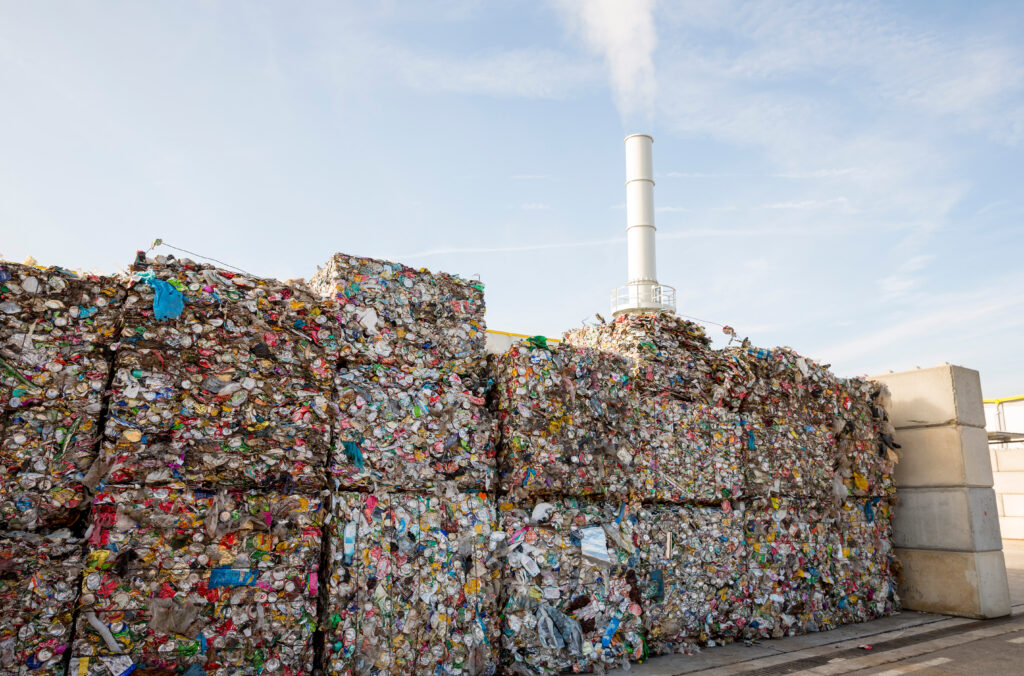One of the materials should be paper, and alternative arrangements must be introduced for estates and multi-occupancy properties, where recycling collections may not be practicable. This will mean one recycling site for every 500 households, collecting three materials including paper, by September 2004.
The Mayor also continued to call for a single waste authority and has modified his stance on incineration.
 Mayor's strategy: Rethinking Rubbish in London |
The new policy document, Rethinking London's Rubbish: The Mayor's Municipal Waste Management Strategy, was launched by London Mayor Ken Livingstone yesterday draw up following a consultation period from September to December 2002.
London's 3.1 million households produced 4.4 million tonnes of municipal waste in 2001-02, with 73% going to landfill, 19% incinerated and only 8% recycled or composted. At the moment, about 1.75 million households in the Greater London area are provided with kerbside recycling collections.
The Mayor's strategy aims to exceed government targets for recycling or composting 25% of household waste by 2005, 30% by 2010 and 33% by 2015.
Commenting on the strategy, Mr Livingstone, said: “Our city is producing more and more waste, with each household creating on average over a tonne of rubbish every year. The amount of landfill space is running out and we need to find other ways to dispose of our waste. Crucially, we need to reduce the amount of rubbish London produces and increase reuse and recycling of waste.”
Green waste
As well as providing collections for dry recyclables, the strategy calls for London boroughs to prepare a “fully costed feasibility study for the borough-wide collection of separated kitchen vegetable waste and green garden waste”. In the case of green garden waste this may be on a seasonal basis. This feasibility study must be presented to the Mayor for consideration by September 2004.
The Mayor believes that rebates will be the best way to increase Londoners' participation in recycling. The strategy suggests that once collections are up and running, boroughs should introduce incentives to increase participation for two or three years.
Residual waste
The Mayor's new strategy seeks to give London more self-sufficiency for its waste. Much of the city's residual waste currently goes to landfills outside of London, but the strategy noted that the estimated landfill capacity in the East of England will only last six years and the South East capacity will fall by four fifths by 2024.
Responding to views in the draft strategy consultation, the Mayor has said he will be looking to promote new technologies for the treatment of residual waste, rather than opting for new incinerators. But the strategy said: “Once all that can be reused, recycled or composted has been removed from the waste stream, value should be recovered from the remainder in the form of other materials and energy.”
London currently has two large incineration plants: Edmonton, opened in 1971 and
SELCHP at Lewisham, opened in 1994. Another plant, proposed by Riverside Resource Recovery Ltd to be built in Bexley, is currently going through a planning inquiry (see letsrecycle.com story).
Mr Livingstone said: “Even with the implementation of the reduction, reuse and recycling proposals in this Strategy, there will still be a lot of waste to deal with. Therefore, I am working to bring new waste treatment technologies into London that mean we will not need to use as much landfill or any more incineration.”
The Mayor said that he had revised his proposal on new incinerators in the light of the government's Renewables Obligation Certificates (ROCs) programme. Energy companies need to generate 10% of their electricity from renewable sources by 2010 under the Renewables Obligation Order 2002. However, while anaerobic digestion, gasification and pyrolysis of waste qualifies for ROCs, straight combustion does not. The Mayor has decided that in the light of this, London's waste should be treated through processes that qualify for ROCs.
Mr Livingstone said: “Taking into account comments in relation to the London Plan and the Waste Strategy, I have revised my proposal on incineration. The new proposal maintains my aim to ensure that we manage London’s waste in the best way possible. If this is done, we shouldn’t need any new incinerators in London. This was strongly supported by Londoners during the consultation.”
Authority
In the long-term, the Mayor believes the best way to achieve sustainable waste management in London is for waste disposal to be under the control of a single waste authority. At the moment, 21 London boroughs work under the auspices of four waste disposal authorities, while the other 16 operate independently.
The strategy said: “The Mayor believes the best way to achieve sustainable waste management in London is for waste disposal to be under the control of a single authority. The Mayor will develop an environmental and business case and consider the views of London waste authorities. In the light of London’s progress towards the 2005/06 targets, the Mayor’s position will be presented to Government, to consider appropriate changes to existing legislation.”
A list of the Mayor's 44 waste policies, drawn from the municipal waste strategy, is available on pages 2 – 3.











Subscribe for free